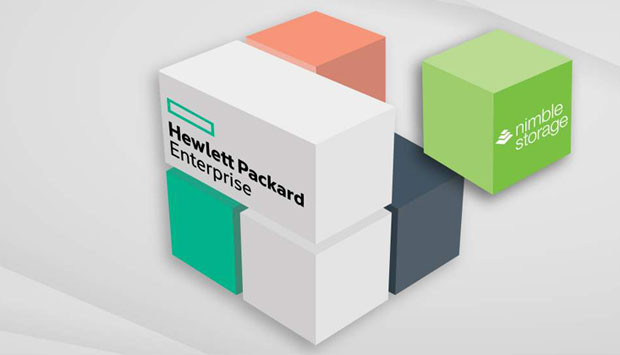Hewlett Packard Enterprise on Tuesday announced a deal to acquire flash storage firm Nimble Storage, once viewed as a darling of Wall Street, for US$12.50 a share in cash, or $1 billion.
HPE also agreed to assume or pay out Nimble Storage’s unvested equity awards, which are valued at $200 million.
Upon completion of the deal, Nimble Storage will merge with a unit of HPE and become a subsidiary of the company.
The Nimble Storage acquisition is meant to strengthen the breadth of HPE’s offerings in the flash storage business, as it competes in the mid-to-high end market following its 2010 acquisition of 3PAR for $2.35 billion.
How Nimble Fits
Founded in 2007 by Chief Strategy Officer Varun Mehta and CTO Umesh Maheshwari, Nimble Storage quickly grew into one of the leading providers of flash storage in the enterprise community.
Nimble sold its CS220 Adaptive Flash arrays to Bay Area accounting firm Mohler Nixon in 2010.
In addition to predictive entry to midrange flash storage solutions, Nimble offers InfoSight Predictive Analytics, which analyzes a company’s critical infrastructure. It is capable of detecting about 90 percent of the storage-related issues and fixes about 85 percent of the issues it finds, the company said.
The firm reached a milestone of 10,000 customers last month and reported revenue of $402 million with 1,300 global employees in its last fiscal year.
Nimble’s technology will strengthen HPE’s flash storage portfolio, noted Antonio Neri, general manager of the Enterprise Group at HPE.
“Together we’ll be able to bring flash optimized data services, which provide the right balance of price, performance and agility to customers across SMB, enterprise and service provider segments,” he pointed out. “In other words, we’ll have a comprehensive, best-in-class portfolio across the full range of the market.”
Bumps in the Road
Nimble Storage faced a “challenge of scale and significant exposure as a standalone company,” which necessitated the deal, noted Nimble CEO Suresh Vasudevan.
The company has been struggling in recent years, falling short on revenue figures while facing higher-than-expected expenses, said Michael Jude, a program manager at Stratecast/Frost & Sullivan.
“Additionally, the company management has seemed somewhat out of touch and has been consistently wrong in its projections,” he told the E-Commerce Times. “This has led to a lower level of market confidence and consequently a lower stock price.”
Shares plunged over the past two years as Nimble consistently missed estimates, reaching a historic low of $6.18 a share in May 2016. Its stock rose 46 percent, or $3.98 a share, to $12.58 on Tuesday’s news of the deal.
The flash storage market has become an increasingly important part of HPE’s business model. The market was estimated at $16 billion in 2016 and is expected to reach $20 billion by the year 2020. The all-flash segment is growing at a rate of 17 percent in compound annual growth, according to HPE.
HPE earlier this year acquired data storage startup SimpliVity, a leading firm in the hyperconverged infrastructure market, for $650 million.
Fierce Rivalry
There is heated competition for the No. 2 spot in the enterprise storage market, amid an overall decline in business in the segment, according to newly released data from IDC. HPE is locked in a virtual tie with IBM and NetApp for the No. 2 position behind Dell, which has a solid lead over the others with about 33 percent of the market.
HPE, IBM and NetApp are locked in a virtual tie with each firm claiming about a 10 percent share. However, HPE has a 0.2 percent edge over NetApp and a 0.1 percent edge over IBM.
Nimble Storage had about 1.4 percent of the global external storage market as of the fourth quarter and 1.9 percent of the global AFA market, according to Liz Conner, research manager for storage systems and software at IDC.
The Nimble Storage acquisition is more of a software play, observed Paul Teich, principal analyst at Tirias Research.
The big hardware OEMs are having a hard time keeping up as software plays an increasingly important role in the market, he added.
“Dell absorbed DSSD for exactly the same reasons — because flash is only the first of a host of new non-volatile memory technologies that will fundamentally transform data center memory and storage architecture,” Teich told the E-Commerce Times.
Making the transition to these new memory and storage architectures “requires integration with operating and orchestration frameworks, plus real-time analytics,” he said.
While external storage is only growing by 2 percent a year, hyperconverged and all flash arrays represent two areas of strong growth within the segment, said Eric Burgener, research manager for storage at IDC.
“The challenge for HPE — and other established enterprise storage providers — is whether they can grow these revenues fast enough to offset the declines in other areas,” he told the E-Commerce Times, “such as hybrid flash arrays and HDD-only arrays.”























































Social Media
See all Social Media